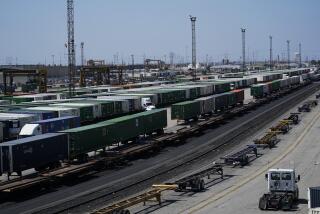FAA Orders New Airport Takeoff Route That Avoids El Segundo
- Share via
The Federal Aviation Administration, responding to years of noise- and safety-related complaints from El Segundo residents, will implement a new takeoff procedure at Los Angeles International Airport designed to ensure that planes head out over the Pacific Ocean, rather than the city.
The new plan, to be implemented in June, will affect commuter turboprop planes, which account for 80% of the inadvertent “early turns” that have been taking 800 low-flying aircraft noisily--and some say dangerously--over the community each month.
Residents of El Segundo, which abuts the south side of the nation’s fourth busiest airport, have been seeking the change since the 1960s and were thrilled with Tuesday’s announcement.
“We’re elated because this is the first good news we’ve had from the airport in a long time,” said El Segundo City Councilman Dick Switz.
Commuter pilots now are guided out of LAX airspace by the voice of an air traffic controller and by a radio beacon 1,500 feet inside the shoreline. That method is less than precise, said Harvey Holden, El Segundo’s airport projects administrator, and sometimes has pilots “turning down Main Street.”
The new procedure--much like that for large airliners--will require pilots to navigate more precisely, using instrument-guided departure procedures, multiple radio beacons and guidance from air traffic controllers, to help pilots make their turns at the right moment, even in inclement weather.
El Segundo officials heralded the new plan as the biggest step in years toward air safety and noise reduction in the community. And officials from the city and the FAA expressed hope that it means a thawing of long-cool relations among El Segundo, the FAA and the airport.
At a news conference overlooking LAX, officials announcing the change had to shout to be heard--and sometimes still weren’t--as aircraft took off Tuesday into a crystal-clear February sky.
“This is an ongoing issue,” said Rep. Jane Harman (D-Rolling Hills), who pushed for the change at a series of meetings late last year. “Clearly, we haven’t eliminated all noise.”
The problem of early turns has long been among the top issues for El Segundo residents seeking peace with their neighbor and a little quiet.
Several years ago, the FAA implemented the new departure procedure for larger, louder airliners departing LAX, and that cut down the almost incessant din heard throughout El Segundo, said Joe Davies, the FAA’s assistant air traffic manager at LAX. But commuter planes taking off from southern runways--nearest El Segundo--into westerly winds still made their turn to the south too soon.
Of the 120 commuter flights that Davies said are sent out each day from the two southern strips, El Segundo officials figure that more than two dozen buzz the city.
After years of squabbling over the issue, the city began collecting data about three years ago. An analysis of flight data supplied by the FAA, along with videotapes showing planes making early turns, did what anecdotal evidence and complaints could not: They convinced federal officials of the seriousness of the problem, Harman said.
“Here’s an example where the community did its homework,” she said. In addition to noise pollution, city officials and residents have long worried about planes at full power climbing above their homes.
All airports are required to have what is commonly called a “clear zone” at both ends of each runway, where construction and gatherings are prohibited. But commuter planes often flew over homes, shops and apartment buildings when they should have been over this zone, city officials said.
“Statistically, this is where airplanes fall apart, at either end of the runway,” said the city’s Holden, adding that he considers the safety benefits of the new plan more important than the noise reduction.
“If you check the clear zone at any airport, you’re going to find aluminum and tools that have come off aircraft,” he said. “We don’t want that stuff falling on us.”
The FAA’s Davies, however, denied that the long-standing takeoff procedures had ever compromised the community’s safety. “This not a safety issue at all from the FAA’s point of view,” he said of the new plans. “This is a noise issue.”
More to Read
Sign up for Essential California
The most important California stories and recommendations in your inbox every morning.
You may occasionally receive promotional content from the Los Angeles Times.













